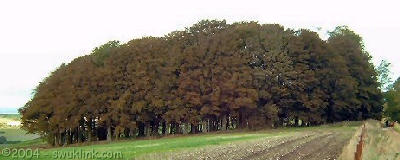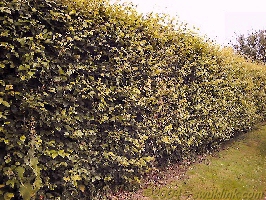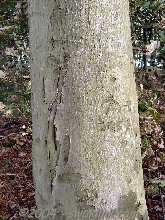The common name for Fagus sylvatica, "beech", is derived from the Scandinavian "bok" meaning book - reference to the use of shavings of its bark to write on before the manufacture of paper. Later, the covers of books were also made of beech.

A stand of beeches on the chalk of the Marlborough Downs in September.
The young leaves of the beech are edible and have a nutty flavour, somewhat like raw peanuts. Within a few weeks they become hard and leathery.
Beech woods are favoured by the bluebell (Campanula rotundifolia) for which they provide they ideal conditions. The flowers are often found forming extensive carpets under the trees early in the spring.
|
| | | For reasons which are not entirely understood, the extensive carpets of bluebells are a uniqely British feature not displayed anywhere else in Europe.
|
| |
| | |
Wild garlic, known as "ramsons" is also found in beech woods.
Of Britian's 1,800 or so species of fungi, some 400 have been recorded in beech woods including the sulphur polypore and the common earthstar.
Four weeping beeches were introduced into Britain from France in 1830. One of these, known as the cathedral beech because of its size, is the largest beech in the UK. Much layered and rooted, its canopy covers almost a third of an acre and is 150 feet across 450 feet in circumference.
Beeches are frequenty seen close together in stands growing stright into the air with the first branches appearing some 15 metres (50 feet) above the ground. Such stands are deliberately planted with the trees close together so that they scramble upwards for light and the trunks grow straight without branching and the consequent knots which weaken the timber.
The strong and hard wood cuts to a very smooth with a sharp tool such as a chisel and accepts a fine finish. It is valued for the making of furniture, including chairs, their stretchers and legs, as well as implements such as rolling pins, mallets, chopping boards, spoons and bowls. The wood is not very resistant to moisture which had precluded is use externally.
The seeds, amongst those known as "mast" are edible if the hard skin is removed from them. They are also rich in oil which can be used as a salad dressing. Beech mast was important as pannage; panning being the release of pigs into woods for fattening in the autumn.

A beech hedge makes a neat and dense barrier.
Beech is favoured for hedges because the young trees, or those trimmed regularly tend not to form the abscision layer which cuts off other decideous leaves from their branches and the brown leaves remain on the branches until the buds start to break. This is also noted in mature trees but only the branches within five or seven metres of the ground tend to hold on to their leaves in winter. A Scotch beech hedge is the largest hedge in the world. Planted in 1746, it is 580 yards long.
The roots of the beech are widespread but shallow. This gives the tree the advantage in that, although it can grow to a height of 30 metres (100 feet), it can survive in soil only 30 cm or so thick. This can also be the downfall of the trees; in the droughts of 1976, many of the roots of the trees died back weakening the hold of the trees in the soil during the severe storms which followed and felled many trees.
|
The tall straight trunks of plantations were certain to takes one's prayers up to heaven but the trees rewarded profanity by dropping their heavy baughs on the head of the offender.
It was believed, perhaps on account of the tree's smooth grey bark, that water taken from its bole would cure imperfections and afflictions of the skin.
| |  |
| | | | kingdom | Plantae | | phylum | Magnoliophyta | | class | Magnoliopsida | | order | Fagales | | family | Fagaceae | | genus | Fagus | | species | Fagus sylvatica |
|
| | | Links to Other Pages on this Site
|
| |
| | |
|
| | | Links to Other Sites
|
| |
| | |
|
| | | Links to Other Pages on this Site
|
| |
| | |
Recommend a Book for this Page
Hits on this page since December 6th| Jan | | |  | | Feb | | |  | | Mar | | |  | | Apr | | |  | | May | | |  | | Jun | | |  | | Jul | | |  | | Aug | | |  | | Sep | | |  | | Oct | | |  | | Nov | | | | | Dec | | |  |
current year:  | | previous year:  |
No messages posted on this page Only Members of the Site can post messages in this section. Signing in is easy from our Home Page. DISCLAIMER: Whilst we endeavour to ensure the content of this site is correct, we cannot undertake that information you find here, is, or will remain accurate and complete. We do not warrant that any information contained on this site is fit for any purpose. If you wish to place reliance on any such information you must check its accuracy by some other means before doing so. MEMBERS get aditional features on our pages and will soon be able to interact with the site and add their views and informastion. Sign up, from the Home-Page, is simple and involves typing in your email address and a password of your choice. If you are in any way connected with any location or interested in the subject mentioned on this page and have an hour or two a month to spare, we would welcome you as a local moderator - please email the webmaster by CLICKING HERE. Privacy Policy
|
| 







